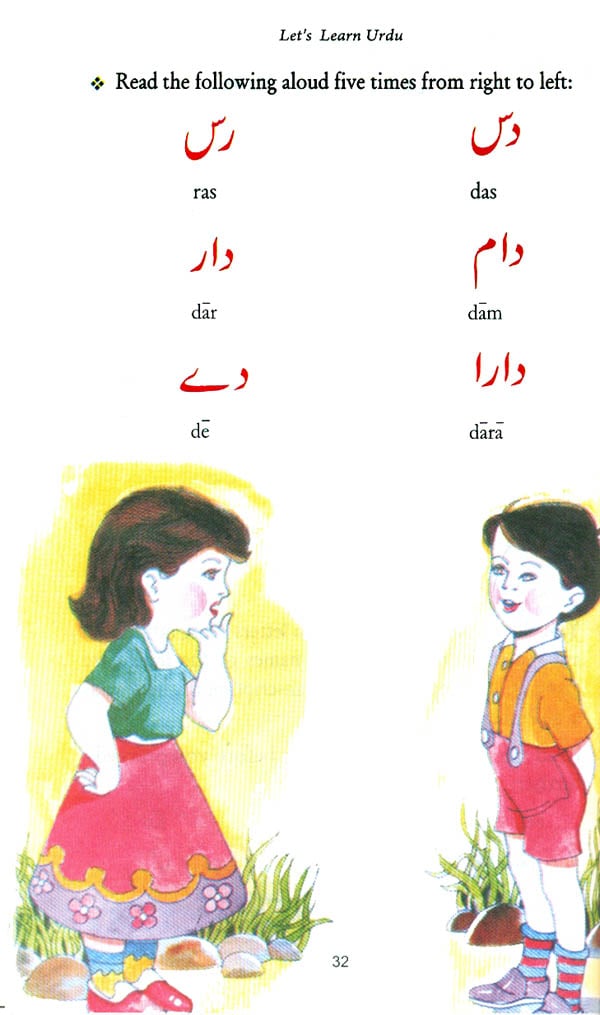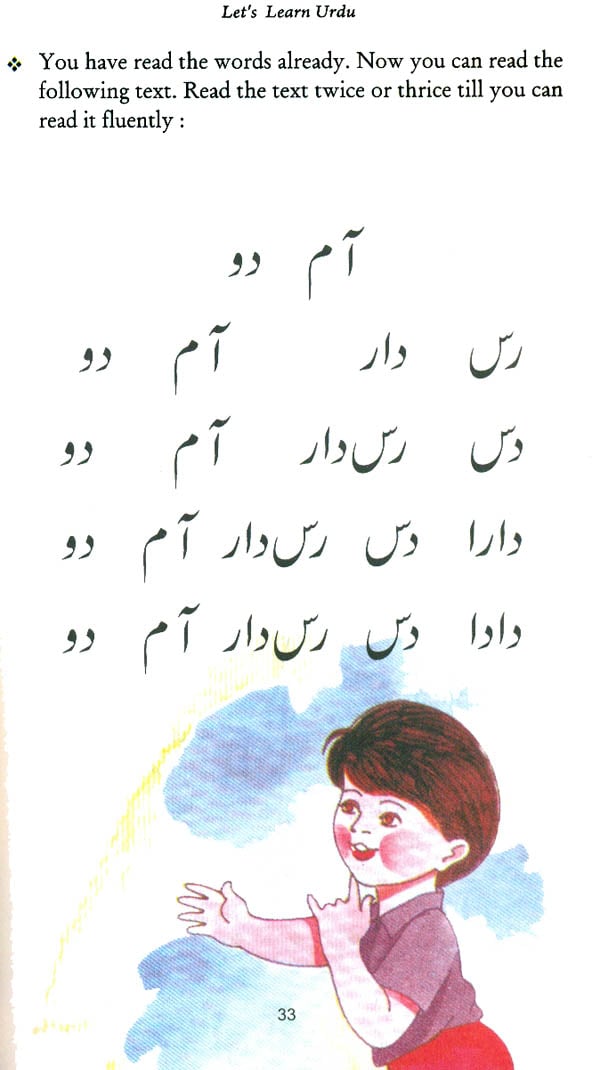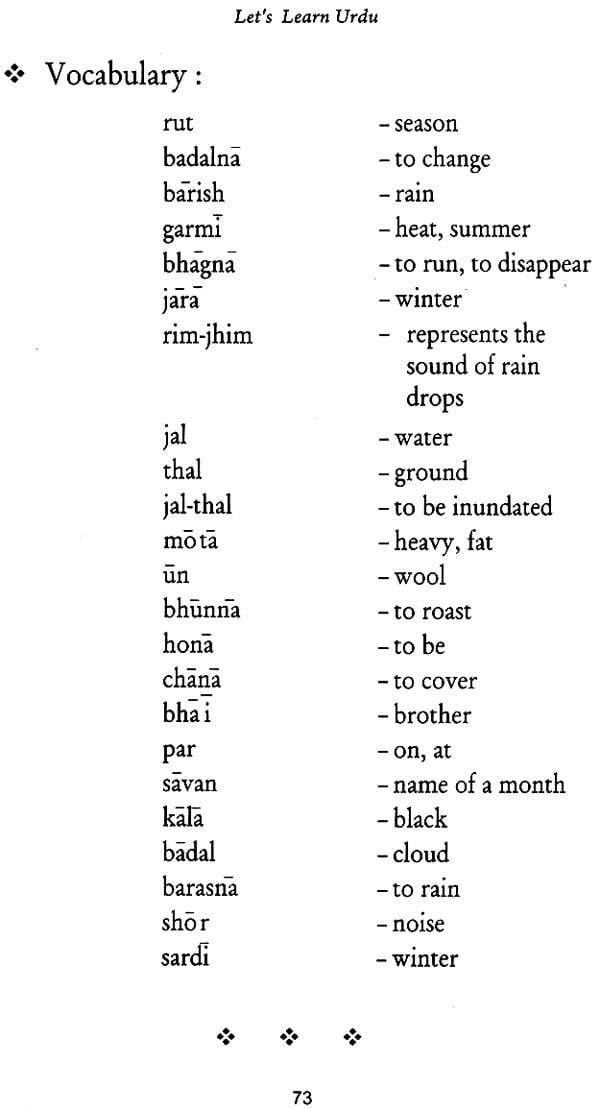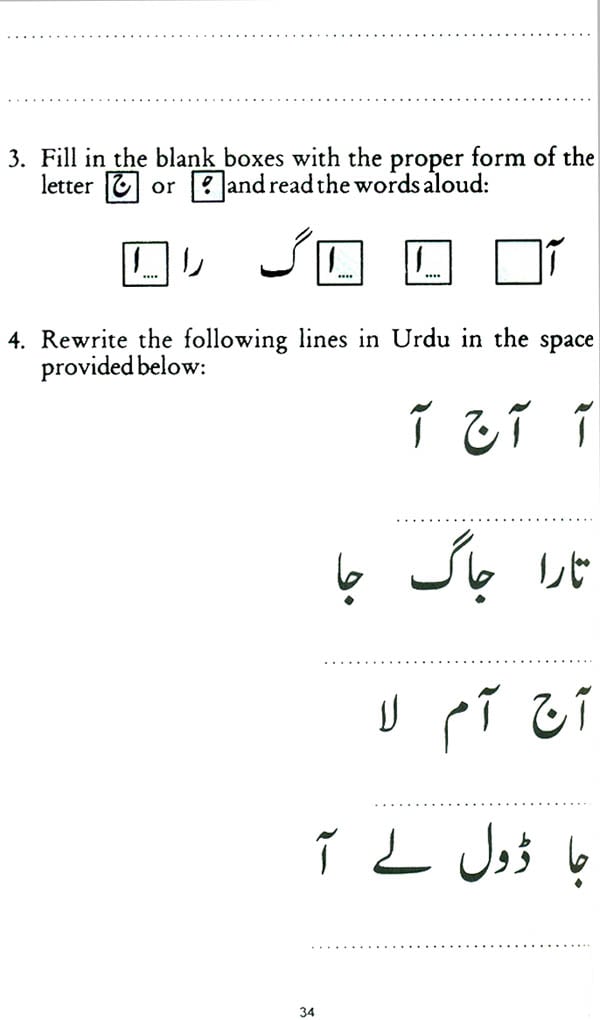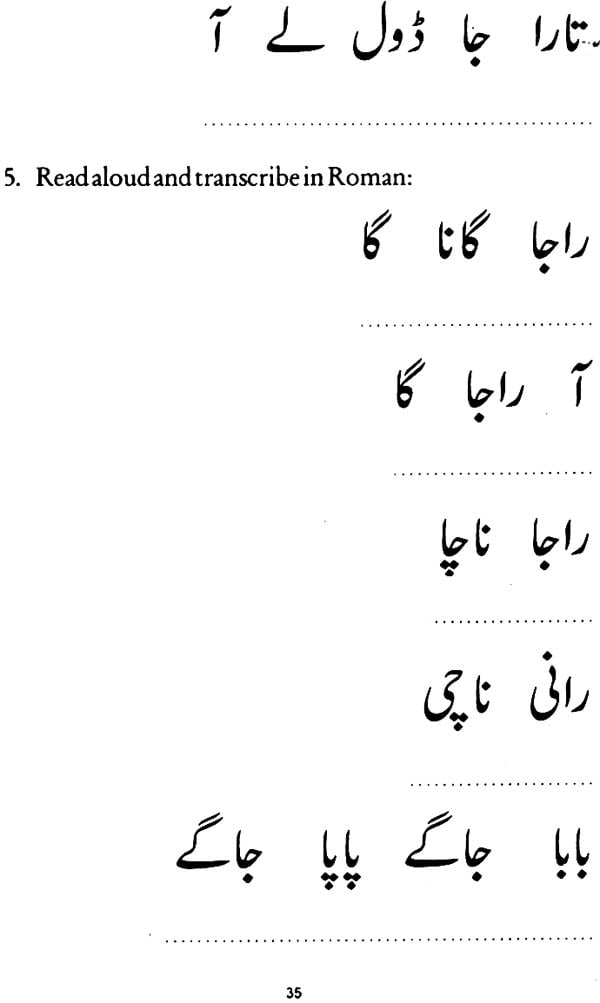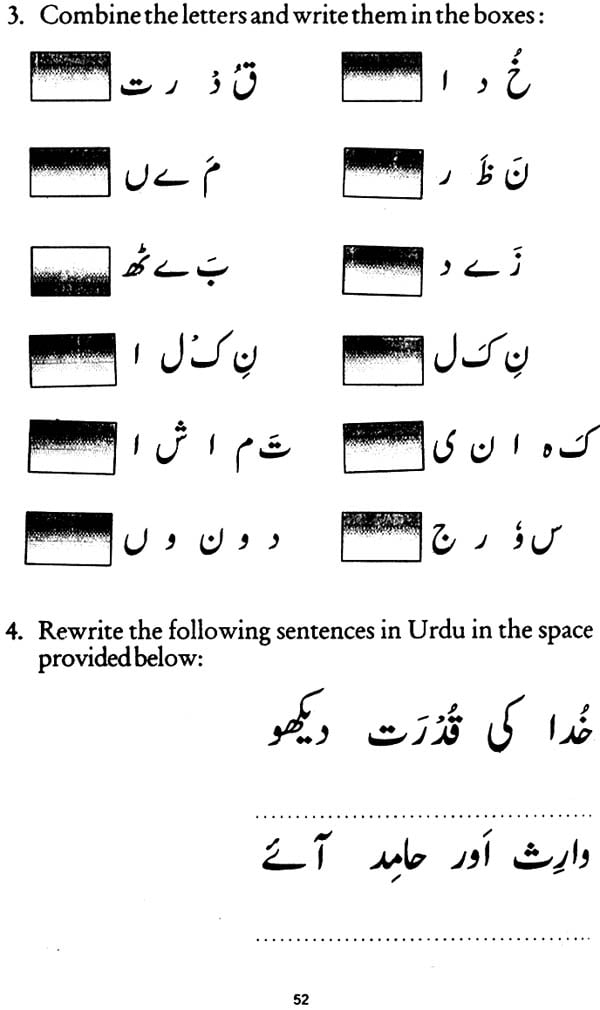
Introductory Urdu (Beginner's Manula for Urdu Script)
Book Specification
| Item Code: | NAK945 |
| Author: | Gopi Chand Narang |
| Publisher: | National Council for Promotion of Urdu Language |
| Language: | Urdu and English |
| Edition: | 2013 |
| Pages: | 188 (Throughout Color Illustrations) |
| Cover: | Paperback |
| Other Details | 8.5 inch x 5.5 inch |
| Weight | 240 gm |
Book Description
ISBN: 9788175875630
National Council for Promotion of Urdu Language is an autonomous organization under the Ministry of Human Resource Development, Govt. of India responsible for promotion of Urdu language. The objectives of the Council are: (1) to promote, develop and propagate Urdu language, (2) to take action for making available in Urdu language the knowledge of scientific and technological development as well as knowledge of ideas evolved in the modem context, (3) to advise the Government of India on issues connected with Urdu language and having bearing on education as may be referred to it and (4) to undertake any other activity for the promotion of Urdu language as may be deemed fit by the Council. The Council is also responsible for providing inputs to Urdu medium education so as there is qualitative improvement in this medium and it conforms to the national standards and objectives.
Urdu is one of the national languages of India included in the VIIIth Schedule of our Constitution and is spoken throughout the country. Large number of our countrymen speak Urdu, but do not know the script. This book by Prof. Gopi Chand Narang, it is hoped, will serve as a beginner’s manual for learning one of the most beautiful Indian scripts - Urdu.
Urdu is an Indo-Aryan language. The script it uses is derived from Arabic and Persian, but to suit the peculiar requirements of Indo-Aryan phonology, particularly aspiration, retroflexion and nasalization, it has been suitably modified. It is cursive in nature. A characteristic feature of this script is that short vowels are not usually indicated, though they can be shown by superscript or subscript marks when necessary. Another important feature is that among the consonants, it has duplicate and triplicate letters which stand for the same sound. It has been necessary to retain them because they are distinctive in the Arabic/Persian loans of Urdu. The Urdu script is written from right to left. The letters are of two types, connectors and non-connectors. The connectors combine with the following letters in the word or the syllable, while the non-connectors cannot combine with the following letters. However, all letters combine with the preceding connector ones. The writing style normally used for Urdu hand-writing or printing is called Nastali q, i.e., beautiful. Since the script is cursive in nature, most of the letters have three shapes, initial when they occur in the beginning, medial when they occur in the middle or finally joined when they occur at the end of a word. The final unjoined shapes is the same as the basic letter. A complete chart of Urdu Characters with all the four shapes is given at the end of the book for reference.
ISBN: 9788175872943
The National Council for Promotion of Urdu Language (NCPUL), an autonomous organization under the Ministry of Human Resource Development, Department of Secondary and Higher Education, Government of India, has been set up to promote, develop and propagate Urdu language. The Council is also responsible for taking appropriate action for making available in Urdu language, the knowledge of scientific and technological development as well as knowledge of ideas, evolved in the modern context. To meet the above objectives the Council has decided to launch a Certificate Course for learning Urdu through the distance mode. The learning material has been, specially prepared by a team of experts drawn from different Universities and Institutions as well as the in house experts. The material was discussed and scrutinised by the committee members under the supervision of Prof. Gopi Chand Narang. It is hoped that teaching through distance mode will meet the wide spread demand for the learning of Urdu.
I must express my profound thanks to Prof. Gopi Chand Narang and all the members of the committee for preparing the text books. I also express my appreciation for Dr. M.J. Warsi, who played an important role in coordinating the Urdu Correspondence Course Scheme.
I hope that the book will be of use to the students who wish to learn one of the most beautiful Indian scripts - Urdu.
This beginner’s Manual for Urdu Script i meant for those who are conversant with spoken Urdu or Hindi, and want to learn Urdu script in the shortest possible time. It is written in the Distance Education mode and everything is self-explanatory. The concepts are introduced gradually, and the characters, words and sentences have been repeated sufficiently so that they are well engrained in the mind of the learner. The Manual is 3coInpanied by a Work Book where things are further explained. The learner must proceed lesson by lesson, and must .applets the related exercises in the Work Book. The Work k contains sufficient reading and writing exercises, which, if followed properly, will render the learning of Urdu script easy enjoyable.
The Urdu script has been introduced in a graded and scientific manner. The learner who wants to learn Urdu alphabet in the traditional order is welcome to do so. A complete chart of the Urdu alphabet in the traditional order is also provided. However, the lessons introduce the Urdu alphabet gradually and semantically. The Urdu letters are of two types, connectors and -connectors. The lessons first introduce the non-connectors which are easy to learn. Similarly, combinations which are simple and easy, are introduced in the beginning. The connectors and concepts which are cooperatively difficult have taken up later. The learner, if he moves step by step according to the order of lessons, and follows instructions while citing the reading and writing exercises in the Work Book, feel any difficulty. Care has been taken to teach the Urdu alphabet through names of objects which are illustrated to make the learning less cumbersome and pleasant.
A short introduction to Urdu script is provided in the beginning. The learner is advised to go through it before beginning the book. Of course, the concepts will become fully clear only after the learner has completed all the lessons and all the exercises. The script, in fact, is introduced in the first 12 lessons. Thus, those learners who may master one lesson each week can learn the Urdu script in a period of three months. However, motivation and learning ability plays a major role in the learning process. The learner is advised to practice writing as much as possible, as nothing reinforces reading more than the writing.
In the Manual new characters and combinations are shown in red boxes. They are drilled enough so that by the end of each lesson the learner can easily recognise and read the new elements. At the end of the lessons a complete chart of the new characters and ‘combinations is again given in red boxes for reinforcement.
The names of the Urdu letters are given at the top of the box while the transcription of the sound is given below. Urdu is rich in duplicators and triplicates, i.e., where some letters stand for one sound. A complete chart of Urdu alphabet denoting the sounds is also given for reference. Complete tables of vowel system and diacritics, traditional order of sequences, as well as the table of different shapes of Urdu letters and their combinations are also provided. All this will be of use and, will help the process of systematic learning.
The Work Book uses turquoise boxes for exercises and broiling the responses. To facilitate the learning process of writing Urdu characters, the direction and movement of herd is indicated by small arrows. New words need sentences are .also given in the dotted (broken) format so that the learner may write over them in pencil, practicing sufficiently to perfect his writing.
The Urdu text has been adopted from the Urdu Ki Nai Kitab- I prepared by me and plashed by the National Council lot Educational Research and Training, New Delhi, which is widely used in many school systems in India. i wish to give my thinks to the Director, NCPUL, Dr. M. Hamidullah Bhat, and to my fellow Committee Members, without whose co-operation help the present project would, not have been completed in time.
| Foreword | 5 |
| Preface | 7 |
| Introduction : Urdu Script | 13 |
| Urdu Alphabet and System of Trnascription | 21 |
| Sequences of Urdu Letters | 25 |
| Exercise Lesson 1 | 27 |
| Exercise Lesson 2 | 31 |
| Exercise Lesson 3 | 35 |
| Exercise Lesson 4 | 40 |
| Exercise Lesson 5 | 45 |
| Exercise Lesson 6 | 51 |
| Exercise Lesson 7 | 56 |
| Exercise Lesson 8 | 61 |
| Exercise Lesson 9 | 67 |
| Exercise Lesson 10 | 74 |
| Exercise Lesson 11 | 81 |
| Exercise Lesson 12 | 89 |
| Exercise Lesson 13 | 96 |
| Exercise Lesson 14 | 100 |
| Exercise Lesson 15 | 104 |
| Chart of Urdu Characters and Their Different Shapes | 107 |
| Chart of Urdu Vowels | 109 |
| Punctuation Marks and Dioacritics | 111 |
| | |
| Foreword | 5 |
| Preface | 7 |
| Exercise Lesson 1 | 13 |
| Exercise Lesson 2 | 17 |
| Exercise Lesson 3 | 21 |
| Exercise Lesson 4 | 25 |
| Exercise Lesson 5 | 29 |
| Exercise Lesson 6 | 33 |
| Exercise Lesson 7 | 37 |
| Exercise Lesson 8 | 41 |
| Exercise Lesson 9 | 45 |
| Exercise Lesson 10 | 51 |
| Exercise Lesson 11 | 57 |
| Exercise Lesson 12 | 61 |
| Exercise Lesson 13 | 65 |
| Exercise Lesson 14 | 71 |
| Exercise Lesson 15 | 75 |
